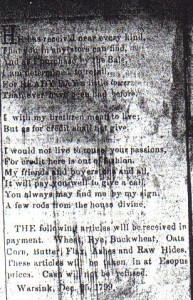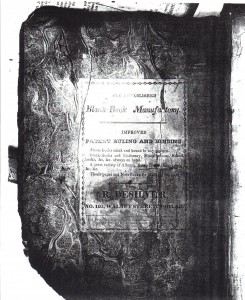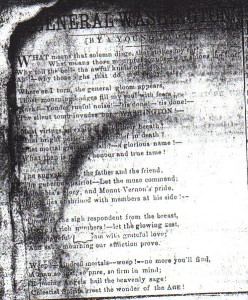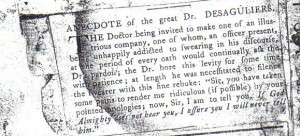The Scrapbook of Jean Laffite
April 27, 2013 in American History, general history, History
“The Journal of Jean Laffite” is a historical manuscript that surfaced in 1948 when John Andrechyne Laflin presented it to the Missouri Historical Society. He claimed that it was a journal kept by Jean Laffite from 1845 to 1850. The authenticity of “the Journal” has been questioned by many, and while not everyone believes it was written by Jean Laffite, it is an artifact from the latter half of the nineteenth century, is written in a hand that looks like the signature of Jean Laffite on his ship’s manifest, and does tell things from the point of view of Jean Laffite and in his voice, to the extent that we know his point of view and voice from other documents. Some believe that the Journal was not written by Jean Laffite himself, but rather by a close associate, one of his sons or by his second wife. Most, however, cast doubt on John Anderchyne’s role in bringing the “The Journal” to light, and many doubt his claims to be related to Jean Laffite.
“The Journal” is written in French and currently resides at the Sam Houston Regional Library and Research Center in Texas. It is not really a journal. It is much more like a memoir written toward the end of his life by an old man about events that happened much earlier. Not only that, but the journal is also a scrapbook.

Jean Laffite discusses martial law in New Orleans under General Andrew Jackson
Kept in a memorandum notebook, the hand-scrawled memoirs are also decorated with scraps of newspaper clippings from a number of different years.
We can learn much about a man from the sorts of things he chooses to record and the types of events he never mentions. But equally revealing is the sort of material he chooses to clip from the newspaper and keep as a memento. Take, for instance, the clipping posted below. Written in rhyme, it tells the terms and conditions under which someone was willing to do business: trade or cash, but no credit.

A poem published in the paper by a merchant who was willing to trade or take cash, but would grant no credit.
In verse, the advertisement runs as follows:
He has received of any kind,
That you in any store can find.
And as I purchase by the Bale,
I am determined to retail
For READY PAY a little lower
Than ever have been had before.
I with my brethren mean to live
But as for credit shall not give.
I would not live to rouse your passions
For credit here is out of fashion.
My friends and buyers one and all
It will pay you well to give a call.
You always may find me by my sign
A few rods from the house divine.
The following articles will be received in payment: Wheat, Rye, Buckwheat, Oats, Corn, Butter, Flax, Ashes and Raw Hides. These articles will be taken in at Esopus prices. Cash will not be refused.
Warsink. December 25, 1799.
While arguably the reason Laffite kept that ad was not because of the verse, but because of the business arrangement that it describes, another clipping is a poem written by a young lady about the death of George Washington.
The poem, while not necessarily high art, does have a very solemn patriotic tone. But the journal is not always solemn, and the clippings are sometimes humorous. Here is an anecdote about swearing that was clipped into the scrapbook of Jean Laffite.
The above clipping tells an anecdote about a Dr. Desaguliers. The Doctor was invited to a party with “illustrious” company, one of whom, an officer, kept swearing and then apologizing for having sworn. This went on for some time, until, tired of this, the Doctor said: “If God Almighty does not hear you, I assure you I will never tell him.”
What can we learn from “The Journal of Jean Laffite”? Most of the facts it relates about his life are already well known. Those facts that are under dispute, will probably remain under dispute. But the scrapbook of Jean Laffite is another matter entirely. From it we can learn about the character of the man who kept it, what he found amusing, poignant, funny or worthy of note.
Sometimes it is not what we say about ourselves that matters the most. It’s how we see others and which of their writings we value that reveals our own true character.
Copyright 2013 Aya Katz



Pam Keyes said on April 27, 2013
The poem ad is for a business in Warsink, Ulster County, N.Y., and refers to Esopus prices, or the prices one could get at Esopus, N.Y., businesses.
Interestingly, the Journal of Jean Laffite ledger book can be dated to the early 1830s by the blank book maker, R. Desilver of Philadelphia.
One can certainly gain some insight into personality based on what is included in such a scrapbook/memoir. In the Laffite Journal, there is not a single instance of a newspaper account about either of the Laffites, but there are two newspaper clippings from 1817 about Aury and Amelia Island. And the Ulster County Gazette clippings date to 1800. Since the clippings could not have been pasted in the book before the 1830s, they had been kept loose together for many years, something else to ponder. Another very interesting aspect is none of the clippings are from French newspapers, or in the French language, although the journal writing is totally Creole French/Spanish amalgamation. Quite curious.
Aya Katz said on April 27, 2013
That is very interesting additional information, Pam. Is there anything to link the Laffites to Ulster County, New York in or around 1799? I mean, anything besides the scrapbook?
Pam Keyes said on April 27, 2013
Not that I know of, but I will do some checking.
Julia said on May 2, 2013
What an interesting story about Jean Laffite and his scrapbook. These are the kind of scrapbooks that interest me, not the modern equivalent where everything has to be designed to the t. I feel like people forget the original intent of a scrapbook, which was to document news and important events in the world a person lived. I found a news scrapbook I had to keep for a class twenty years ago, and it was fun remembering events from that time.
Aya Katz said on May 2, 2013
Thanks, Julia. It’s my favorite type of scrapbook, too, and used to be a very common thing in the past. Today, maybe only historians are aware of the practice, as most people do this sort of scrap-booking online, in places such as Facebook. And I am afraid that a hundred or more years from now, nothing will remain of our online scrapbooks. You are lucky that you got to keep a real, news-based scrapbook. That might end up being a treasure for future generations to find.
PATRICK lafitte said on March 22, 2017
Le Journal de Jean Lafitte est un faux.C’est une certitude absolue.Je suis français et je vous assure qu’il est impossible à un français d’écrire des mots qui n’existent pas en français( ni en créole) et de faire des phrases qui n’ont aucun sens.( 200 à 300 erreurs) .L traduction anglaise du Journal est fausse,mal traduite,rectifiant les erreurs,ajoutant des choses et des noms qui ne sont pas écrites dans le journal en français.Et puis plein d’erreurs historiques( page 157 Jean Laffite parle de 1909,1912 et 1909 alors qu’il était mort depuis longtemps. Page 193 parle de Truijillo Santo Domingo alors que Trujiillo a été le nom de Santo Domingo de 1936 à 1961.;Etc…etc…Ce journal n’a pas été écrit par un français et après 1919 puisque Jean Lafitte écrit cette date dans son “Journal”
Governor said on March 22, 2017
Jean Laffite n’était pas français. Sa grand-mère était espagnole. Sa langue maternelle était l’espagnol.
PATRICK lafitte said on March 22, 2017
Le Journal de Jean Lafitte est un faux.C’est une certitude absolue.Je suis français et je vous assure qu’il est impossible à un français d’écrire des mots qui n’existent pas en français( ni en créole) et de faire des phrases qui n’ont aucun sens.( 200 à 300 erreurs) .L traduction anglaise du Journal est fausse,mal traduite,rectifiant les erreurs,ajoutant des choses et des noms qui ne sont pas écrites dans le journal en français.Et puis plein d’erreurs historiques( page 157 Jean Laffite parle de 1909,1912 et 1919alors qu’il était mort depuis longtemps. Page 193 parle de Truijillo Santo Domingo alors que Trujiillo a été le nom de Santo Domingo de 1936 à 1961.;Etc…etc…Ce journal n’a pas été écrit par un français et après 1919 puisque Jean Lafitte écrit cette date dans son “Journal”